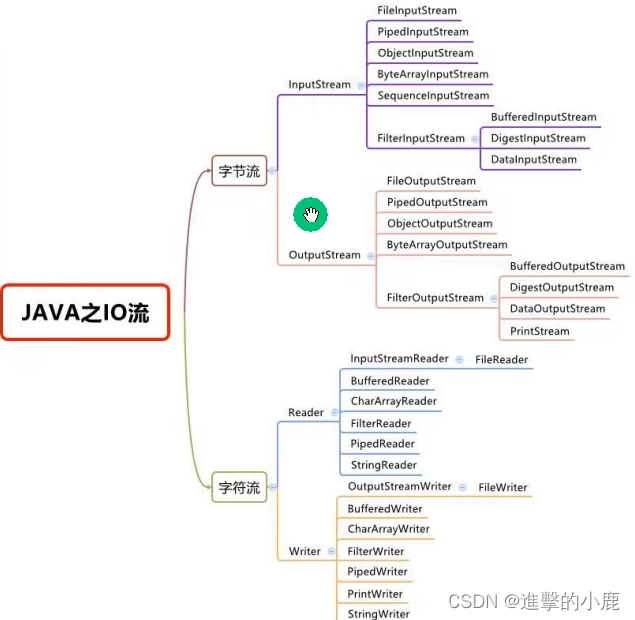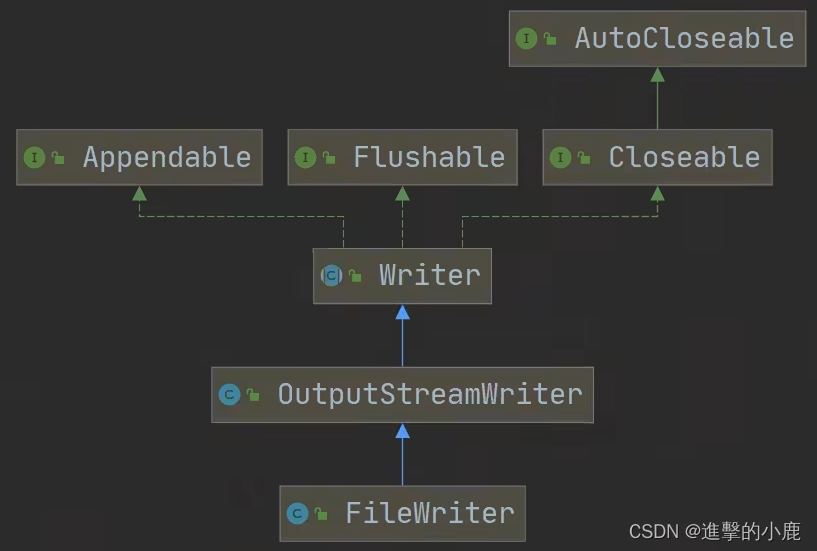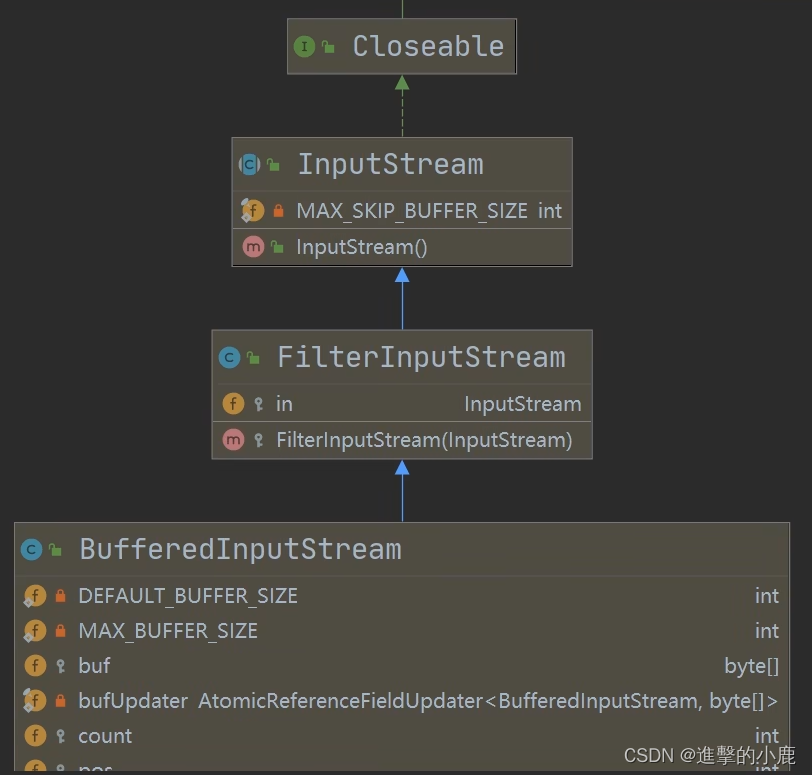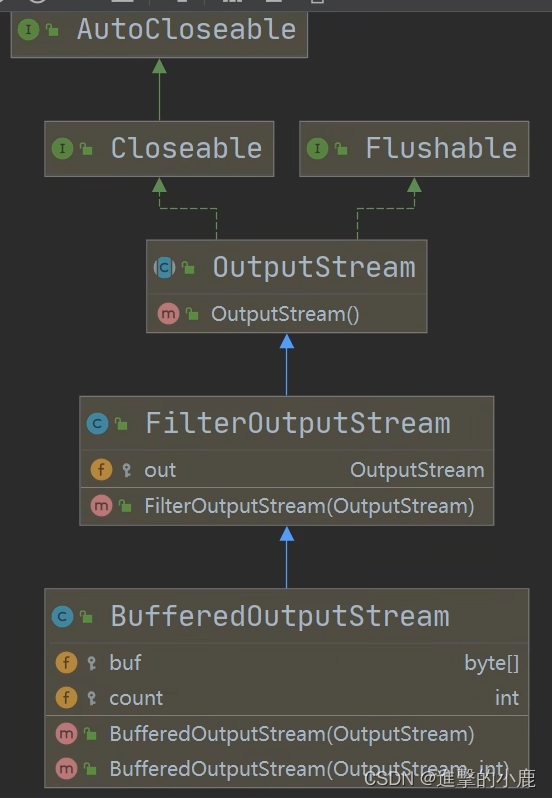文章目录
- 创建文件
- 流的分类
- InputStream:字节输入流
- FileOutputStream:字节输出流
- 文件拷贝案例
- FileReader 和 FileWriter:字符输入/输出流
- 节点流和处理流
- 处理流-BufferedReader和BufferedWriter
- 处理流-BufferedInputStream和BufferedOutputStream
- 对象流(处理流)-ObjectInputStream和ObjectOutputStream
- 标准输入\输出流
- 转换流-InputStreamReader和OutputStreamWriter
- 打印流-PrintStream和PrintWriter
- Properties类
- 案例代码
其中的输入与输出是相对java程序而言,并且是以“流(steam)”的方式进行
java.io包下提供了各种“流”类和接口

创建文件
-
创建文件对象
- 方式1 new File(pathname) // 根据路径构建一个File对象
- 方式2 new File(File parent,String child) // 根据父目录文件+子路径构建
- 方式3 new File(String parent,String child) // 根据父目录+子路径构建
-
创建新文件
- 对象.createNewFile()
代码
package com.xiaolu.file_;
import org.junit.jupiter.api.Test;
import java.io.File;
import java.io.IOException;
/**
* @author 林小鹿
* @version 1.0
* 创建文件
*/
public class FileCreate {
public static void main(String[] args) {
}
// 方式1 new File(pathname)
@Test
public void create01() throws IOException {
String filePath = "D:\\1.txt";
File file = new File(filePath);
file.createNewFile();
System.out.println("文件创建成功");
}
@Test
// 方式2 new File(File parent,String child) // 根据父目录文件+子路径构建
public void create02() {
File parentFile = new File("D:\\");
String fileName = "2.txt";
File file = new File(parentFile, fileName);
try {
file.createNewFile();
System.out.println("创建成功");
} catch (IOException e) {
e.printStackTrace();
}
}
// 方式3 new File(String parent,String child) // 根据父目录+子路径构建
@Test
public void create03() {
String parentPath = "d:\\";
String fileName = "3.txt";
File file = new File(parentPath, fileName);
try {
file.createNewFile();
System.out.println("创建成功");
} catch (IOException e) {
e.printStackTrace();
}
}
}
相关方法
- mkdir:创建目录
- mkdirs:创建多级目录
- 其余自行查找
流的分类
- 按操作数据单位不同分为:字节流(8bt)二进制文件,字符流(按字符)文本文件
- 按数据流的流向不同分为:输入流,输出流
- 按流的角色的不同分为:节点流,处理流/包装流
| (抽象基类) | 字节流 | 字符流 |
|---|---|---|
| 输入流 | InputStream | Reader |
| 输出流 | OutputStream | Writer |
InputStream:字节输入流
- InputStream抽象类是所有类字节输入流的超类
- InputStream常用的子类
- FilelnputStream:文件输入流
- BufferedInputStream:缓冲字节输入流
- ObjectInputStream:对象字节输入流
代码
package com.xiaolu.file_.inputstream_;
import org.junit.jupiter.api.Test;
import java.io.FileInputStream;
import java.io.FileNotFoundException;
import java.io.IOException;
/**
* @author 林小鹿
* @version 1.0
* 字节输入流
*/
public class FileInputStream_ {
public static void main(String[] args) {
}
/**
* 单个字节的读取,效率比较低 -> 使用 read(byte[] b)来优化读取
*/
@Test
public void read01() {
String filePath = "d:\\1.txt";
int readData = 0;
FileInputStream fileInputStream = null;
try {
// 创建了 FileInputStream 对象,用于读取 文件
fileInputStream = new FileInputStream(filePath);
//从该输入流读取一个字节的数据。如果没有输入可用,此方法将阻止。
//如何返回-1,表示读取完毕
while ((readData = fileInputStream.read()) != -1) {
System.out.print((char) readData);
}
} catch (IOException e) {
e.printStackTrace();
} finally {
// 关闭文件流,释放资源
try {
fileInputStream.close();
} catch (IOException e) {
e.printStackTrace();
}
}
}
/**
* 使用 read(byte[] b)来优化读取
*/
@Test
public void read02() {
String filePath = "d:\\1.txt";
int readLen = 0;
byte[] buf = new byte[8]; // 一次读取8个字节
FileInputStream fileInputStream = null;
try {
// 创建了 FileInputStream 对象,用于读取 文件
fileInputStream = new FileInputStream(filePath);
//从输入流读取一些字节数,并将它们存储到缓冲区b 。 实际读取的字节数作为整数返回。 该方法阻塞直到输入数据可用,检测到文件结束或抛出异常。
//如何返回-1,表示读取完毕
// 如果读取正常,返回实际读取的字节数
while ((readLen = fileInputStream.read(buf)) != -1) {
System.out.print(new String(buf,0, readLen));
}
} catch (IOException e) {
e.printStackTrace();
} finally {
// 关闭文件流,释放资源
try {
fileInputStream.close();
} catch (IOException e) {
e.printStackTrace();
}
}
}
}
FileOutputStream:字节输出流
讲数据写入到文件中,如果该文件不存在,则创建该文件
- new FileOutputStream(filePath)创建方式,当写入内容是,会覆盖原来的内容
- new FileOutputStream(filePath,true)创建方式,当写入内容是,是追加到文件后面
代码
package com.xiaolu.file_;
import org.junit.jupiter.api.Test;
import java.io.FileOutputStream;
import java.io.IOException;
/**
* @author 林小鹿
* @version 1.0
*/
public class FileOutputStrean_ {
public static void main(String[] args) {
}
@Test
public void writeFile() {
// 创建FileOutputStream对象
//1.new FileOutputStream(filePath)创建方式,当写入内容是,会覆盖原来的内容
//2.new FileOutputStream(filePath,true)创建方式,当写入内容是,是追加到文件后面
String filePath = "d:\\a.txt";
FileOutputStream fileOutputStream = null;
try {
// fileOutputStream = new FileOutputStream(filePath);
fileOutputStream = new FileOutputStream(filePath,true);
// 写入一个字节
// fileOutputStream.write('a');
// 写入字符串
String str = "hello,Linxiaolu!";
// getBytes 可以把一个字符串转成字节数组
// fileOutputStream.write(str.getBytes()); // 转成byte数组
/*
第三种方法
write(byte[]b,int off,int len) 将Len字节从位于偏移量off的指定字节数组写入此文件输出流
*/
fileOutputStream.write(str.getBytes(), 0, str.length()); // 等价于 fileOutputStream.write(str.getBytes())
} catch (IOException e) {
e.printStackTrace();
} finally {
try {
fileOutputStream.close();
} catch (IOException e) {
e.printStackTrace();
}
}
}
}
文件拷贝案例
package com.xiaolu.file_;
import java.io.FileInputStream;
import java.io.FileOutputStream;
import java.io.IOException;
/**
* @author 林小鹿
* @version 1.0
* 完成对文件的拷贝
*/
public class FileCopy {
public static void main(String[] args) {
//1、创建文件的输入流,将文件读入到程序
//2、创建文件的输出流,将读取到的文件数据,写入到指定的文件
String srcFilePath = "C:\\Users\\lin\\Pictures\\wallhaven-pkgkkp.png";
String destFilePath = "D:\\临时\\1.png";
FileInputStream fileInputStream = null;
FileOutputStream fileOutputStream = null;
try {
fileInputStream = new FileInputStream(srcFilePath);
fileOutputStream = new FileOutputStream(destFilePath);
// 定义一个字节数组,提高读取效率
byte[] buf = new byte[1024];
int readLen = 0;
while ((readLen = fileInputStream.read(buf)) != -1) {
//读取到后,就写入到文件通过fileOutputStream
//即,是一边读,一边写
fileOutputStream.write(buf, 0, readLen); // 一定要用这个方法
}
System.out.println("拷贝ok~");
} catch (IOException e) {
e.printStackTrace();
} finally {
try {
// 关闭输入流和输出流,释放资源
if (fileInputStream != null) {
fileInputStream.close();
}
if (fileOutputStream != null) {
fileOutputStream.close();
}
} catch (IOException e) {
e.printStackTrace();
}
}
}
}
FileReader 和 FileWriter:字符输入/输出流
FileReader相关方法

- new FileReader(File/String)
- read:每次读取单个字符,返回该字符,如果到文件末尾返回-1
- read(char[]):批量读取多个字符到数组,返回读取到的字符数,如果到文件末尾返回-1相关API:
- new String(char[]):将char[]转换成String
- new String(char[],off,len):将char[]的指定部分转换成String
代码
package com.xiaolu.file_;
import org.junit.jupiter.api.Test;
import java.io.FileNotFoundException;
import java.io.FileReader;
import java.io.IOException;
/**
* @author 林小鹿
* @version 1.0
* 字符流
*/
public class FileReader_ {
public static void main(String[] args) {
}
/**
* 单个字符读取
*/
@Test
public void reader01() {
String filePath = "d:\\news.txt";
// 1、创建FileReader 对象
FileReader fileReader = null;
int data = 0;
try {
fileReader = new FileReader(filePath);
// 循环读取,方式一
while ((data = fileReader.read()) != -1) {
System.out.print((char) data);
}
} catch (IOException e) {
e.printStackTrace();
} finally {
try {
if (fileReader != null) {
fileReader.close();
}
} catch (IOException e) {
e.printStackTrace();
}
}
}
/**
* 字符数组读取文件
*/
@Test
public void reader02() {
String filePath = "d:\\news.txt";
// 1、创建FileReader 对象
FileReader fileReader = null;
int readLen = 0;
char[] buf = new char[8];
try {
fileReader = new FileReader(filePath);
// 循环读取,方式二
//循环读取使用read(buf),返回的是实际读取到的字符数
//如果返回-1,说明到文件结束
while ((readLen = fileReader.read(buf)) != -1) {
System.out.print(new String(buf, 0, readLen));
}
} catch (IOException e) {
e.printStackTrace();
} finally {
try {
if (fileReader != null) {
fileReader.close();
}
} catch (IOException e) {
e.printStackTrace();
}
}
}
}
FileWriter常用方法

- new FileWriter(File/String):覆盖模式,相当于流的指针在首端
- new FileWriter(File/String,true):追加模式,相当于流的指针在尾端
- write(int):写入单个字符
- write(char[]):写入指定数组
- write(char[],off,len):写入指定数组的指定部分
- write(string):写入整个字符串
- write(string,off,Ien):写入字符串的指定部分
相关APl:String类:toCharArray:将String转换成char[
注意:
FileWriter使用后,必须要关闭(close)或刷新(flush),否则写入不到指定的文件!
代码
package com.xiaolu.file_;
import java.io.File;
import java.io.FileWriter;
import java.io.IOException;
/**
* @author 林小鹿
* @version 1.0
*/
public class FileWriter_ {
public static void main(String[] args) {
String filePath = "d:\\临时\\note.txt";
FileWriter fileWriter = null;
char[] chars = {'a','b','c'};
try {
fileWriter = new FileWriter(filePath); // 覆盖
// 3)write(int):写入单个字符
fileWriter.write('H');
// 4)write(char[]):写入指定数组
fileWriter.write(chars);
// 5)write(char[],off,Len):写入指定数组的指定部分
fileWriter.write("\n林小鹿ex".toCharArray(), 0, 4);
// 6)write(string):写入整个字符串
fileWriter.write("老上海");
// 7)write(string,off,Len):写入字符串的指定部分
fileWriter.write("进击的小鹿 ", 0, 4);
} catch (IOException e) {
e.printStackTrace();
} finally {
try {
// fileWriter.flush();
// 关闭文件流,等价于 flush + 关闭
fileWriter.close();
System.out.println("程序结束");
} catch (IOException e) {
e.printStackTrace();
}
}
}
}
节点流和处理流
- 节点流可以从一个特定的数据源读写数据,如FileReader、.FileWriter[源码]
- 灵活性低,只能针对特定的数据进行操作
- 处理流(也叫包装流)是“连接”在已存在的流(节点流或处理流)之上,为程序提供更为强大的读写功能,如BufferedReader、BufferedWriter[源码]
- 可操作实现了Reader类的所有数据类型,可对节点流进行一个包装,提高灵活性

节点流和处理流的区别和联系
- 节点流是底层流/低级流,直接跟数据源相接。
- 处理流包装节点流,既可以消除不同节点流的实现差异,也可以提供更方便的方法来完成输入输出。[源码理解]
- 处理流(也叫包装流)对节点流进行包装,使用了修饰器设计模式,不会直接与数据源相连[模拟修饰器设计模式]
处理流的功能主要体现在以下两个方面:
- 性能的提高:主要以增加缓冲的方式来提高输入输出的效率。
- 操作的便捷:处理流可能提供了一系列便捷的方法来一次输入输出大批量的数据,使用更加灵活方便
处理流-BufferedReader和BufferedWriter
BufferedReader和BufferedWriter属于字符流,是按照字符来读取数据的
关闭时处理流,只需要关闭外层流即可底层还是节点流
BufferedReader代码
package com.xiaolu.file_;
import java.io.BufferedReader;
import java.io.FileReader;
/**
* @author 林小鹿
* @version 1.0
*/
public class BufferedReader_ {
public static void main(String[] args) throws Exception {
String filePath = "d:\\news.txt";
// 创建bufferedReader
BufferedReader bufferedReader = new BufferedReader(new FileReader(filePath));
// 读取
String line; // 按行读取,效率高
// bufferedReader.readLine是按行读取文件,当返回null时,表示文件读取完毕
while ((line = bufferedReader.readLine()) != null) {
System.out.println(line);
}
// 关闭流,这里只需要关闭 BufferedReader,因为底层会自动去关闭 节点流(FileReader)
bufferedReader.close();
}
}
BufferedWriter代码
package com.xiaolu.file_;
import java.io.BufferedWriter;
import java.io.FileWriter;
import java.io.IOException;
/**
* @author 林小鹿
* @version 1.0
*/
public class BufferedWriter_ {
public static void main(String[] args) throws IOException {
String filePath = "d:\\ok.txt";
BufferedWriter bufferedWriter = new BufferedWriter(new FileWriter(filePath));
// BufferedWriter bufferedWriter = new BufferedWriter(new FileWriter(filePath, true)); // 追加
bufferedWriter.write("你好,世界");
bufferedWriter.newLine(); // 插入一个和系统相关的换行符
bufferedWriter.write("你好,世界");
bufferedWriter.newLine();
bufferedWriter.write("你好,世界");
bufferedWriter.newLine();
// 关闭
bufferedWriter.close();
}
}
案例
package com.xiaolu.file_;
import java.io.*;
/**
* @author 林小鹿
* @version 1.0
* BufferedReader和BufferedWriter是按照字符操作,不要去操作二进制文件[声音,视频,doc,pdf,图片等等],可能造成文件损坏
*/
public class BufferedCopy_ {
public static void main(String[] args) {
String srcFilePath = "d:\\ok.txt";
String destFilePath = "d:\\python\\ok2.txt";
BufferedReader bufferedReader = null;
BufferedWriter bufferedWriter = null;
String line;
try {
bufferedReader = new BufferedReader(new FileReader(srcFilePath));
bufferedWriter = new BufferedWriter(new FileWriter(destFilePath));
// readLine 是读取一行的内容,但是没有换行符
while ((line = bufferedReader.readLine()) != null) {
bufferedWriter.write(line);
// 插入一个换行符
bufferedWriter.newLine();
}
System.out.println("拷贝完毕~");
} catch (IOException e) {
e.printStackTrace();
} finally {
try {
if (bufferedReader != null) {
bufferedReader.close();
}
if (bufferedWriter != null) {
bufferedWriter.close();
}
} catch (IOException e) {
e.printStackTrace();
}
}
}
}
处理流-BufferedInputStream和BufferedOutputStream
- BufferedInputStream是字节流在创建BufferedInputStream时,会创建一个内部缓冲区数组
- BufferedOutputStream是字节流,实现缓冲的输出流,可以将多个字节写入底层输出流中,而不必对每次字节写入调用底层系统


案例代码
package com.xiaolu.file_;
import java.io.*;
/**
* @author 林小鹿
* @version 1.0
* 拷贝视频、图片等二进制文件
* 同样也可以操作文本文件,因为都是安装字节来操作的
*/
public class BufferedCopy02 {
public static void main(String[] args){
String srcFilePath = "d:\\python\\1.png";
String destFilePath = "d:\\python\\2.jpg";
BufferedInputStream bis = null;
BufferedOutputStream bos = null;
try {
bis = new BufferedInputStream(new FileInputStream(srcFilePath));
bos = new BufferedOutputStream(new FileOutputStream(destFilePath));
// 循环的读取文件,并写入到 destFilePath
// 创建缓存,提高效率
byte[] buff = new byte[1024];
int readLen = 0;
while ((readLen = bis.read(buff)) != -1) {
bos.write(buff, 0, readLen);
}
System.out.println("拷贝成功~");
} catch (IOException e) {
e.printStackTrace();
} finally {
// 关闭流,关闭外层的处理流即可
try {
if (bis != null) {
bis.close();
}
if (bos != null) {
bos.close();
}
} catch (IOException e) {
e.printStackTrace();
}
}
}
}
对象流(处理流)-ObjectInputStream和ObjectOutputStream
- 序列化和反序列化
- 序列化就是在保存数据时,保存数据的值和数据类型
- 反序列化就是在恢复数据时,恢复数据的值和数据类型
- 需要让某个对象支持序列化机制,则必须让其类是可序列化的,为了让某个类是可序列化的该类必须实现如下两个接口之一:
- Serializable // 这是一个标记接口,没有方法
- Externalizable // 该接口有方法需要实现,因此我们一般实现上面的Serializable接口
ObjectOutputStream代码
package com.xiaolu.file_;
import java.io.FileOutputStream;
import java.io.ObjectOutputStream;
import java.io.Serializable;
/**
* @author 林小鹿
* @version 1.0
* 序列化
*/
public class ObjectOutputStream_ {
public static void main(String[] args) throws Exception {
// 序列化后,保存的文件格式,不是纯文本,而是按照他的格式来保存的
String filePath = "d:\\data.dat";
ObjectOutputStream oos = new ObjectOutputStream(new FileOutputStream(filePath));
//序列化数据到e:\data.dat
oos.writeInt(100); //int->Integer(实现了Serializable)
oos.writeBoolean(true); //boolean->Boolean(实现了Serializable)
oos.writeChar('a'); //char->Character(实现了Serializable)
oos.writeDouble(9.5); //double->Double(实现了Serializable)
oos.writeUTF("韩顺平教育"); //String
// 保存一个dog对象
oos.writeObject(new Dog("小狗", 10));
// 关闭
oos.close();
System.out.println("数据保存完毕(序列化形式)");
}
}
// 如果需要序列化某个类的对象,需要实现 Serializable 接口
class Dog implements Serializable {
private String name;
private int age;
public Dog(String name, int age) {
this.name = name;
this.age = age;
}
public String getName() {
return name;
}
public void setName(String name) {
this.name = name;
}
public int getAge() {
return age;
}
public void setAge(int age) {
this.age = age;
}
}
ObjectInputStream代码
package com.xiaolu.file_;
import java.io.FileInputStream;
import java.io.ObjectInputStream;
/**
* @author 林小鹿
* @version 1.0
* 反序列化
*/
public class ObjectInputStream_ {
public static void main(String[] args) throws Exception{
// 指定反序列化的文件
String filePath = "d:\\data.dat";
ObjectInputStream ois = new ObjectInputStream(new FileInputStream(filePath));
// 读取(反序列化)的顺序需要和你保存数据(序列化)的顺序一致,否则会出现异常
System.out.println(ois.readInt());
System.out.println(ois.readBoolean());
System.out.println(ois.readChar());
System.out.println(ois.readDouble());
System.out.println(ois.readUTF());
// dog 的编译类型是 Object,dog 的运行类型是Dog
//1.如果我们希望调用Dog的方法,需要向下转型
//2.需要我们将Dog类的定义,拷贝到可以引用的位置
Object dog = ois.readObject();
System.out.println("运行类型=" + dog.getClass());
System.out.println(dog); // 底层 Object -> Dog
// 关闭
ois.close();
}
}
细节
- 读写顺序要一致
- 要求实现序列化或反序列化对像,需要实现Serializable
- 序列化的类中建议添加SerialVersionUID,为了提高版本的兼容性
- 序列化对象时,默认将里面所有属性都进行序列化,但除了static或transient修饰的成员
- 序列化对象时,要求里面属性的类型也需要实现序列化接口
- 序列化具备可继承性,也就是如果某类已经实现了序列化,则它的所有子类也已经默认实
现了序列化
标准输入\输出流
- System.in
- 类型为:InputStream
- System.in 编译类型:Inputstream
System.in 运行类型:BufferedInputstream
表示的是标准输入 键盘
- System.out
- 类型为:PrintStream
- 编译类型Printstream
运行类型PrintStream
表示标准输出 显示器
转换流-InputStreamReader和OutputStreamWriter
用于字节流转换成字符流
- InputStreamReader:Readert的子类,可以将InputStream(字节流)包装成Reader(字符流)
- OutputStreamWriter:Writert的子类,实现将OutputStream(字节流)包装成Vriter(字符流)
- 当处理纯文本数据时,如果使用字符流效率更高,并且可以有效解决中文问题,所以建议将字节流转换成字符流
- 可以在使用时指定编码格式比如utf-8,gbk,gb2312,ISO8859-1等)
InputStreamReader代码
package com.xiaolu.file_;
import java.io.BufferedReader;
import java.io.BufferedWriter;
import java.io.FileInputStream;
import java.io.InputStreamReader;
/**
* @author 林小鹿
* @version 1.0
* 演示使用InputStreamReader转换流解决中文乱码问题
* 将字节流FileInputStream转成字符流InputStreamReader,指定编码gbk/utf-8
*/
public class InputStreamReader_ {
public static void main(String[] args) throws Exception{
String filePath = "d:\\ok.txt";
//1.把FileInputStream转成InputStreamReader
//2.指定编码gbk
InputStreamReader isr = new InputStreamReader(new FileInputStream(filePath), "gbk");
// 3.最后,使用处理流 BufferedReader 处理,把InputStreamReader传入BufferedReader
BufferedReader br = new BufferedReader(isr);
// 4.读取
String s = br.readLine();
System.out.println("读取到的内容=" + s);
// 5.关闭
br.close();
}
}
OutputStreamWriter代码
package com.xiaolu.file_;
import org.junit.jupiter.api.condition.OS;
import java.io.FileOutputStream;
import java.io.IOException;
import java.io.OutputStreamWriter;
/**
* @author 林小鹿
* @version 1.0
* 把FileOutputStream字节流,转成字符流OutputStreamWriter
* 指定处理的编码gbk/Utf-8/Utf8
*/
public class OutputStreamWriter_ {
public static void main(String[] args) throws IOException {
String filePath = "d:\\python\\0.txt";
String charSet = "gbk";
OutputStreamWriter osw = new OutputStreamWriter(new FileOutputStream(filePath), charSet);
osw.write("进击的小鹿");
osw.close();
System.out.println("按照" + charSet + "保存文件成功");
}
}
打印流-PrintStream和PrintWriter
打印流只有输出流,没有输入流
在默认情况下,Printstream输出数据的位置是标准输出,即显示器
PrintStream代码
package com.xiaolu.file_;
import java.io.IOException;
import java.io.PrintStream;
/**
* @author 林小鹿
* @version 1.0
*/
public class PrintStream_ {
public static void main(String[] args) throws IOException {
PrintStream out = System.out;
//在默认情况下,Printstream输出数据的位置是标准输出,即显示器
/*
public void print(String s) {
if (s =null)
s "null";
write(s);
}
*/
out.print("john,hello");
//因为print底层使用的是write,所以我们可以直接调用write进行打印/输出
out.write("林小鹿,你好".getBytes());
out.close();
//我们可以去修改打印流输出的位置/设备
//1.输出修改成到"d:\\f1.txt"
//2."hello,林小鹿~"就会输出到e:\f1.txt
//3.public static void setOut(PrintStream out){
//checkI0();
//setOvt0(out); // native方法,修改了out
// }
System.setOut(new PrintStream("d:\\f1.txt"));
System.out.println("hello,林小鹿~");
}
}
PrintWriter代码
package com.xiaolu.file_;
import java.io.FileWriter;
import java.io.IOException;
import java.io.PrintWriter;
/**
* @author 林小鹿
* @version 1.0
*/
public class PrintWriter_ {
public static void main(String[] args) throws IOException {
// PrintWriter printWriter = new PrintWriter(System.out);
PrintWriter printWriter = new PrintWriter(new FileWriter("d:\\f2.txt"));
printWriter.println("你好");
// 不关闭流的话无法写入
printWriter.close();
}
}
Properties类
Properties父类是Hashtable,底层就是Hashtable核心方法
- 专门用于读写配置文件的集合类
- 配置文件的格式:
键=值
键=值
- 配置文件的格式:
- 注意:键值对不需要有空格,值不需要用引号一起来。默认类型是String
- Properties的常见方法
- Ioad:加载配置文件的键值对到Properties对象
- Iist:将数据显示到指定设备/流对象
- getProperty(key):根据键获取值
- get(key):根据键获取值
- setProperty(key,value):设置键值对到Properties对象,若不存在则添加
- store:将Propertiest中的键值对存储到配置文件,在idea中,保存信息到配置文件,如果含有中文,会存储为unicode码
代码
package com.xiaolu.properties_;
import java.io.*;
import java.util.Properties;
/**
* @author 林小鹿
* @version 1.0
* Properties父类是Hashtable,底层就是Hashtable核心方法
*/
public class Properties01_ {
public static void main(String[] args) throws IOException {
// // 传统方法
// // 读取 mysql.properties 文件,并得到ip, user 和 pwd
// BufferedReader br = new BufferedReader(new FileReader("src\\mysql.properties"));
// String line = "";
// while ((line = br.readLine()) != null) {
System.out.println(line);
// String[] split = line.split("=");
// System.out.println(split[0] + "的值是:"+split[1]);
// }
// br.close();
// 使用Properties读取 mysql.properties 文件
// 1、创建Properties对象
Properties properties = new Properties();
// 2、加载指定配置文件
properties.load(new FileReader("src\\mysql.properties"));
// 3、把k-v显示控制台
properties.list(System.out);
// 4、根据key 获取对应的值
String user = properties.getProperty("user");
String pwd = properties.getProperty("pwd");
System.out.println("用户名="+user);
System.out.println("密码是="+pwd);
// 创建、添加、修改
properties.setProperty("charSet", "utf8");
properties.setProperty("user", "汤姆"); // 中文的话保存的是中文的 unicode码值
// 存储
// properties.store(new FileOutputStream("src\\mysql2.properties"), null); // 这里的null为注释,可置为空值
properties.store(new FileOutputStream("src\\mysql2.properties"), "This is a comment and can be set to null");
System.out.println("存储成功~~~");
}
}
案例代码
案例一
package com.xiaolu.file_.homework;
import java.io.BufferedWriter;
import java.io.File;
import java.io.FileWriter;
import java.io.IOException;
/**
* @author 林小鹿
* @version 1.0
* 文件创建并写入数据
*/
public class work01 {
public static void main(String[] args) throws IOException {
String directorPath = "d:\\python\\mytemp";
File file = new File(directorPath);
if (!(file.exists())) {
// 创建
if (file.mkdirs()) {
System.out.println("创建"+directorPath+"创建成功");
}else {
System.out.println("创建"+directorPath+"创建失败");
}
}
String filePath = directorPath + "\\hello.txt";
file = new File(filePath);
if (!(file.exists())) {
// 创建文件
if (file.createNewFile()) {
System.out.println(filePath + "创建成功~");
BufferedWriter bw = new BufferedWriter(new FileWriter(file));
bw.write("hello,world~~ 林小鹿");
bw.close();
}else {
System.out.println(filePath + "创建失败~");
}
}else {
System.out.println(filePath + "已经存在,不再重复创建");
}
}
}
案例二
package com.xiaolu.file_.homework;
import org.junit.jupiter.api.Test;
import javax.swing.plaf.synth.SynthOptionPaneUI;
import java.io.*;
import java.util.Properties;
/**
* @author 林小鹿
* @version 1.0
*/
public class work02 {
public static void main(String[] args) throws IOException {
String filePath = "src\\mysql.properties";
Properties properties = new Properties();
properties.load(new FileReader(filePath));
String name = properties.get("name") + "";
int age = Integer.parseInt(properties.get("age") + "");
String color = properties.get("color") + "";
Dog dog = new Dog(name, age, color);
System.out.println(dog);
//将创建的Dog对象,序列化到文件dog.dat文件
String serFilePath = "src\\dog.dat";
ObjectOutputStream oos = new ObjectOutputStream(new FileOutputStream(serFilePath));
oos.writeObject(dog);
oos.close();
System.out.println("dog对象序列化完成...");
}
@Test
public void m1() throws IOException, ClassNotFoundException {
String serFilePath = "src\\dog.dat";
ObjectInputStream ois = new ObjectInputStream(new FileInputStream(serFilePath));
Dog dog = (Dog) ois.readObject();
System.out.println("======反序列化后dog=======");
System.out.println(dog);
ois.close();
}
}
class Dog implements Serializable{
private String name;
private int age;
private String color;
public Dog(String name, int age, String color) {
this.name = name;
this.age = age;
this.color = color;
}
public String getName() {
return name;
}
public void setName(String name) {
this.name = name;
}
public int getAge() {
return age;
}
public void setAge(int age) {
this.age = age;
}
public String getColor() {
return color;
}
public void setColor(String color) {
this.color = color;
}
@Override
public String toString() {
return "Dog{" +
"name='" + name + '\'' +
", age=" + age +
", color='" + color + '\'' +
'}';
}
}
版权声明:本文内容由互联网用户自发贡献,该文观点与技术仅代表作者本人。本站仅提供信息存储空间服务,不拥有所有权,不承担相关法律责任。如发现本站有涉嫌侵权/违法违规的内容, 请发送邮件至 dio@foxmail.com 举报,一经查实,本站将立刻删除。

